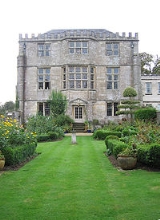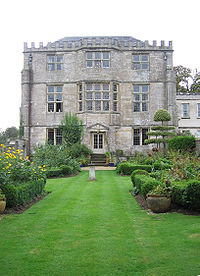
Newark Park
Encyclopedia

English country house
The English country house is a large house or mansion in the English countryside. Such houses were often owned by individuals who also owned a London house. This allowed to them to spend time in the country and in the city—hence, for these people, the term distinguished between town and country...
of Tudor
Tudor style architecture
The Tudor architectural style is the final development of medieval architecture during the Tudor period and even beyond, for conservative college patrons...
origins located near the village of Ozleworth
Ozleworth
Ozleworth is a village and civil parish in Gloucestershire, England, approximately south of Gloucester. It lies in the Cotswolds, an Area of Outstanding Natural Beauty.-History:...
, Wotton-under-Edge
Wotton-under-Edge
Wotton-under-Edge is a market town within the Stroud district of Gloucestershire, England. Located near the southern end of the Cotswolds, the Cotswold Way long-distance footpath passes through the town. Standing on the B4058 Wotton is about from the M5 motorway. The nearest railway station is...
, Gloucestershire
Gloucestershire
Gloucestershire is a county in South West England. The county comprises part of the Cotswold Hills, part of the flat fertile valley of the River Severn, and the entire Forest of Dean....
. The house sits in an estate of 700 acres (2.8 km²) at the southern end of the Cotswold
Cotswolds
The Cotswolds are a range of hills in west-central England, sometimes called the Heart of England, an area across and long. The area has been designated as the Cotswold Area of Outstanding Natural Beauty...
escarpment
Escarpment
An escarpment is a steep slope or long cliff that occurs from erosion or faulting and separates two relatively level areas of differing elevations.-Description and variants:...
with views down the Severn Valley
Severn Valley (England)
The Severn Valley is a rural area of mid-western England, through which the River Severn runs and the Severn Valley Railway steam heritage line operates, starting at its northernmost point in Bridgnorth, Shropshire and running south for 16 miles to Bewdley, Worcestershire in the Wyre...
to the Severn Estuary
River Severn
The River Severn is the longest river in Great Britain, at about , but the second longest on the British Isles, behind the River Shannon. It rises at an altitude of on Plynlimon, Ceredigion near Llanidloes, Powys, in the Cambrian Mountains of mid Wales...
. The house and estate have been in the care of the National Trust
National Trust for Places of Historic Interest or Natural Beauty
The National Trust for Places of Historic Interest or Natural Beauty, usually known as the National Trust, is a conservation organisation in England, Wales and Northern Ireland...
since 1946.
Newark Park was originally a four-storey
Storey
A storey or story is any level part of a building that could be used by people...
(three storeys over a basement) Tudor
Tudor period
The Tudor period usually refers to the period between 1485 and 1603, specifically in relation to the history of England. This coincides with the rule of the Tudor dynasty in England whose first monarch was Henry VII...
hunting lodge built between 1544 and 1556 for Sir Nicholas Poyntz
Nicholas Poyntz
Sir Nicholas Poyntz was a prominent English courtier during the latter part of Henry VIII's reign. There is a portrait drawing by Hans Holbein the Younger in the Royal Collection and an oil portrait after the same artist based on the drawing in the National Portrait Gallery, London...
(d.1557), whose main seat was at Acton Court
Acton Court
Acton Court is a recently restored Tudor house on Latteridge Lane, Iron Acton, South Gloucestershire, England.The Poyntz family owned the property from 1364 until 1680. Nicholas Poyntz added the East Wing onto the existing moated manor house shortly before 1535. Construction took about 9 months...
near Bristol
Bristol
Bristol is a city, unitary authority area and ceremonial county in South West England, with an estimated population of 433,100 for the unitary authority in 2009, and a surrounding Larger Urban Zone with an estimated 1,070,000 residents in 2007...
, some fifteen miles to the south, an easy day's ride. Poyntz was a Groom of the Privy Chamber to Henry VIII
Henry VIII of England
Henry VIII was King of England from 21 April 1509 until his death. He was Lord, and later King, of Ireland, as well as continuing the nominal claim by the English monarchs to the Kingdom of France...
and had recently remodeled Acton Park in anticipation of a royal visit. "Newark is equally fashionable in terms of its precocious classicism," observes Nicholas Cooper, who points out its rigorously symmetrical front (illustration), unprecedented in the main body of any great house in its time, and the correct Tuscan order
Tuscan order
Among canon of classical orders of classical architecture, the Tuscan order's place is due to the influence of the Italian Sebastiano Serlio, who meticulously described the five orders including a "Tuscan order", "the solidest and least ornate", in his fourth book of Regole generalii di...
of its original main door. The house was then called "New Work" and was partly constructed with building materials from the recently dissolved
Dissolution of the Monasteries
The Dissolution of the Monasteries, sometimes referred to as the Suppression of the Monasteries, was the set of administrative and legal processes between 1536 and 1541 by which Henry VIII disbanded monasteries, priories, convents and friaries in England, Wales and Ireland; appropriated their...
Kingswood Abbey
Kingswood Abbey
Kingswood Abbey was a Cistercian abbey, located in the village of Kingswood near Wotton-under-Edge, Gloucestershire, England.- History :Kingswood Abbey was founded in the year 1169 by William of Berkeley in accordance with the wishes of his uncle, Roger II of Berkeley, and colonised from the...
, some five miles away. The lodge was three bays wide and of single-pile construction, one room deep. In the basement was a kitchen, there were two reception rooms on the ground floor and a banqueting room on the first. Modest sleeping quarters were provided on the third floor, and the roof was flat so that it could be used as a pleasurable lookout over the surrounding countryside, in which it enjoys a commanding position. It was built at about the same time as nearby Siston Court
Siston
Siston is a small village in South Gloucestershire, England east of Bristol Castle, ancient centre of Bristol, recorded historically as Syston, Sistone, Syton, Sytone and Systun etc. The village lies at the confluence of the two sources of the Siston Brook, a tributary of the River Avon...
was being built by Sir Maurice Denys
Maurice Denys
Sir Maurice Denys was an English lawyer in London, a property speculator during the Dissolution of the Monasteries, during which period he served as a "powerful figure at the Court of Augmentations", a Member of Parliament for Malmesbury in Wiltshire, Treasurer of Calais and the builder of Siston...
(d.1563), first cousin of Poyntz's wife Jane Berkeley. Poyntz's original lodge now forms the eastern part of the present structure.
In 1600 the lodge was sold to the Low family of London
London
London is the capital city of :England and the :United Kingdom, the largest metropolitan area in the United Kingdom, and the largest urban zone in the European Union by most measures. Located on the River Thames, London has been a major settlement for two millennia, its history going back to its...
who in 1672 significantly extended the building by the addition of a second four-storey building to the west, which was joined to the original by a passage stairway
Stairway
Stairway, staircase, stairwell, flight of stairs, or simply stairs are names for a construction designed to bridge a large vertical distance by dividing it into smaller vertical distances, called steps...
creating an H-shaped footprint. The Lows owned Newark Park until 1722 when it was sold for £6,010 (equivalent to £ today) to the Harding family who after making some minor alterations sold it to James Clutterbuck. The Clutterbucks engaged the architect James Wyatt
James Wyatt
James Wyatt RA , was an English architect, a rival of Robert Adam in the neoclassical style, who far outdid Adam in his work in the neo-Gothic style.-Early classical career:...
to remodel it into a four-square house in 1790. Their improvements included the creation of a formal deer-park to the south of the house and landscaping of the rest of the grounds. The Clutterbucks left Newark in 1860 and let it out, but even though it was tenanted
Leasehold estate
A leasehold estate is an ownership of a temporary right to land or property in which a lessee or a tenant holds rights of real property by some form of title from a lessor or landlord....
the occupants continued to make alterations and improvements. The King family, who were shipping merchants
Ship transport
Ship transport is watercraft carrying people or goods . Sea transport has been the largest carrier of freight throughout recorded history. Although the importance of sea travel for passengers has decreased due to aviation, it is effective for short trips and pleasure cruises...
from Bristol
Bristol
Bristol is a city, unitary authority area and ceremonial county in South West England, with an estimated population of 433,100 for the unitary authority in 2009, and a surrounding Larger Urban Zone with an estimated 1,070,000 residents in 2007...
took the leasehold in 1898 and added servants' quarters
Servants' quarters
Servants' quarters are those parts of a building, traditionally in a private house, which contain the domestic offices and staff accommodation. From the late 17th century until the early 20th century they were a common feature in all large houses...
on the north side, installed a hot-air heating system
Central heating
A central heating system provides warmth to the whole interior of a building from one point to multiple rooms. When combined with other systems in order to control the building climate, the whole system may be a HVAC system.Central heating differs from local heating in that the heat generation...
and ran hot water
Water heating
Water heating is a thermodynamic process using an energy source to heat water above its initial temperature. Typical domestic uses of hot water are for cooking, cleaning, bathing, and space heating...
to the second floor. The Kings stayed at Newark until 1949 when the last of the line died and the then owner, Mrs Power-Clutterbuck, gave Newark Park and its estates to the National Trust.
When the Trust took ownership they did not open Newark Park to the public but instead let it out to tenants who ran it as a nursing home
Nursing home
A nursing home, convalescent home, skilled nursing unit , care home, rest home, or old people's home provides a type of care of residents: it is a place of residence for people who require constant nursing care and have significant deficiencies with activities of daily living...
. By 1970 the house was in a state of disrepair and the gardens over-grown. It was in this state that American
United States
The United States of America is a federal constitutional republic comprising fifty states and a federal district...
architect
Architecture
Architecture is both the process and product of planning, designing and construction. Architectural works, in the material form of buildings, are often perceived as cultural and political symbols and as works of art...
Robert (Bob) Parsons (1920–2000), who had long expressed a desire to take on an English country house in need of repair, took the tenancy and began a painstaking programme of renovation
Renovation
Renovation is the process of improving a structure. Two prominent types of renovations are commercial and residential.-Process:The process of a renovation, however complex, can usually be broken down into several processes...
, conservation and rehabilitation to both the house and the grounds. It was due to Bob Parson's efforts that the architectural importance of the house was acknowledged and the Grade I listing achieved.

